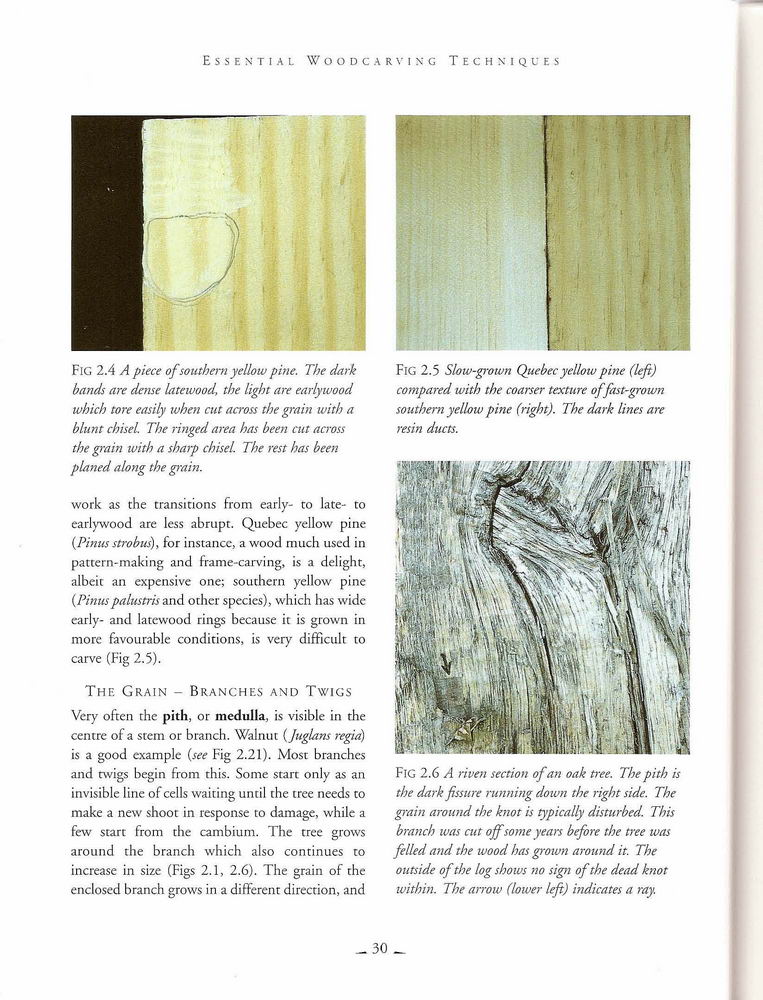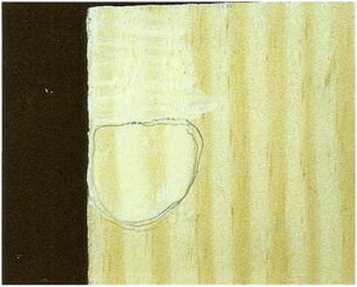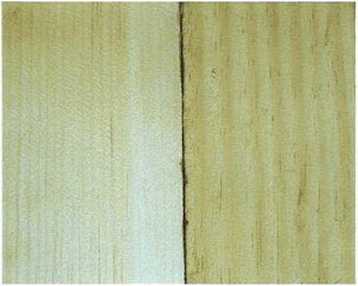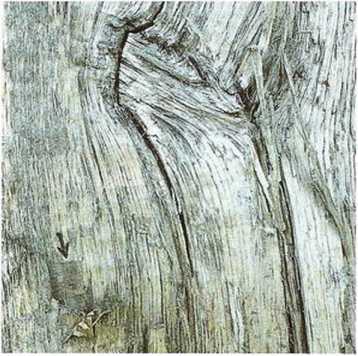essentÊrving°30

Essen ti al Woodcarving Techniques


Fig 2.4 A piece of Southern yeUow pine. The dark bands are dense latewood\ the light are earlywood which tore easily when cut across the gmin with a blunt chisei The ringed aren has beeti cut across the grain with a sharp chisei The rest bas been planed along the gmin.
work as the transitions from early- co late- to earlywood are less abrupt. Quebec yellow pine {Pinus strobits), for instancc, a wood much uscd in pattern-making and frame-carving, is a delight, albeit an cxpensive one; Southern yellow pine (Pinuspalustris and orher specics), which has widc early- and latewood rings because it is grown in morc favourable conditions, is vcry difficult to carve (Fig 2.5).
Thf. Grain - Branches and Twigs Vcry often the pith, or medulla, is visible in rhe centre of a stem or branch. Walnut (Juglans regia) is a good cxample (see Fig 2.21). Most branches and twigs begin from rhis. Some start only as an invisible linÄ™ of cells waiting until the tree needs to make a new shoot in response to damage, while a few start from the cambiuin. The trcc grows around the branch which also continues to inerease in size (Figs 2.1, 2.6). The grain of the enclosed branch grows in a different direction, and
Fig 2.5 Slow-gown Quebecyellow pine (lefi) compared with the coarser texture of fast-grown Southern yellow pine (right). The dark lines are resin duets.

Fig 2.6 A riven section of an oak tree. The pith is the dark fissure running doiun the right side. The grain around the knot is typically disturbed. This branch was cut ojf some years before the tree was felled and the wood has grown around it. The outside of the log shows no sign of the dead knot within. The arrow (lower lefi) itidicates a my.
— 30 _
Wyszukiwarka
Podobne podstrony:
essent?rving?66 Essen ti al Woodcarvixg Techniques Fig 5.1 Oak leafstudies by a student (Howard Spie
essent?rving?96 Essen ti al W o o dcaryinc T e c h niq u e s Fig S.18 Cutting across tbe gmin wbere
essent?rving?18 Essen tul Woodcarning Techniques Fig 1.29 A bench holdfast in use. Fig 1.28 A univer
essent?rving?84 Essential Woodcarving Techniques Fig 7.7 This is how a piece of card would look if f
essent?rving?12 E S S E N TI AL W O O D C A R VI X G TECHNIQ U E S The Nos. 4-7 are gouges whose sha
essent?rving?14 pp Essential Woodcarvixg Techniques W Fig 1.17 Ttoo grounders. Very narrow old Engli
essent?rving?98 Essential Woodcarving Techniques Fig 9.1 Various lines. The one on the left Incks in
essent?rving?52 Essential Woodcarying Techniques Fig 14.3 Mov mg water. Fig 14.4 Drawings devełoping
Slajd68 Bielactwo - kamuflaż Fig. 3.9.2 (a-d)Camouflaging of facia I vrtiligo in Iwo dark skinned pa
Slajd68 Bielactwo - kamuflaż Fig. 3.9.2 (a-d)Camouflaging of facia I vrtiligo in Iwo dark skinned pa
48,49 v3D Eguipment Write the number of each piece of eguipment next to the scissors forceps examina
S5006938 (2) not only their late chronological position but is also an important piece of evidence a
art marq? G [ossary of Terms Background veneer. The piece of veneer that has the design or pattern d
essent?rving?68 Essen tial Woodcarving Techniques FlG 15.16 The fint cut into the serif on an M. Fig
essent?rving?34 Essen tial Woodcarying Techniques softwoods are evergreen and hardwoods are dcciduou
essent?rving?40 Essen tial Woodcarying Techniques FlG 2.20 Arrow Crosstree (Dick Onians), carued in
więcej podobnych podstron